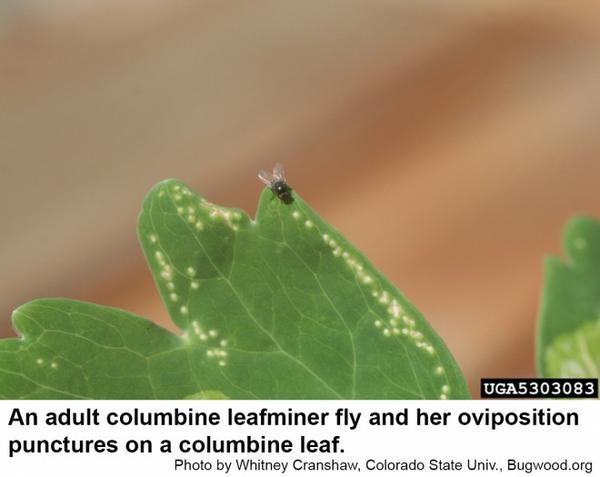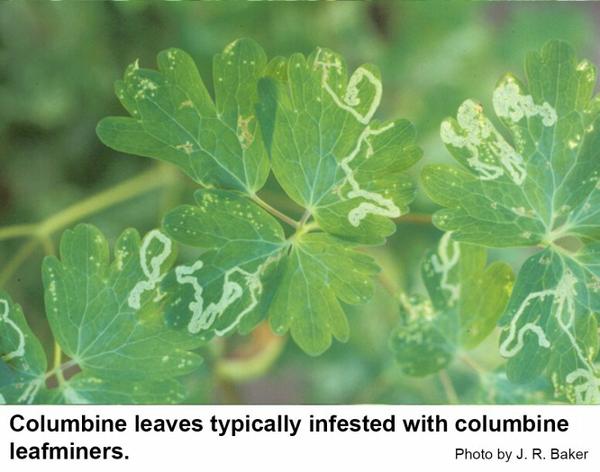Description and Biology
Columbine leafminers, Phytomyza miniscula, are very common pests of columbine in gardens. The tiny brown to black flies lay their eggs in the leaves from the underside and their maggots tunnel through the leaves as they grow. Sometimes every leaf of every clump may be disfigured by the leafminers. When the maggots finish feeding, they cut a crescent shaped hole in the leaf and pupate outside in a small seed-like capsule called the puparium. In about two weeks another generation of leafminer flies emerges to repeat the "wheel of existence." Up to five generations occur from May to September. This pest overwinters as pupae inside their puparia.
Host Plants
John Shread (1968) said it best, "The columbine leaf miner (Phytomyza minuscula) is a pest of columbine and aster. It is much less destructive in sunny exposures than in shaded ones. Early spring foliage becomes infested by adults that emerge from overwintered pupae. As the season advances a great deal of the foliage on badly infested plants may have light grayish to whitish serpentine mines which are most conspicuous in the upper surface of the leaves . . ."
Residential Recommendation
Leafminer flies have a number of parasites, and their populations often collapse if no pesticides are applied. However, this natural control usually happens too late to prevent unacceptable aesthetic damage. Orthene or imidacloprid should give adequate control of the columbine leafminer. However, the appearance of the infested plants will not improve until new growth emerges to obscure the earlier damage. Orthene and imidacloprid are readily available in most hardware stores and garden centers. We have had good results using imidacloprid as a soil drench early in the spring.
References
- Leafminer Flies. S. D. Frank, J. R. Baker and S. B. Bambara. 2010. Entomology Insect Notes, NC State Extension Publications.
- Leaf Miners and Their Control. Schread, J. C. 1971. Connecticut Agr. Exp. Sta., New Haven, Bull. No. 693. 15 pp.
- Serpentine mines in columbine leaves caused by a leafminer. Smitley, D. 2012. Michigan State Univ. Extension News.
- Extension Plant Pathology Publications and Factsheets
- Horticultural Science Publications
- North Carolina Agricultural Chemicals Manual
For assistance with a specific problem, contact your local N.C. Cooperative Extension Center.
This Factsheet has not been peer reviewed.
Publication date: Dec. 21, 2013
Reviewed/Revised: Nov. 3, 2023
Recommendations for the use of agricultural chemicals are included in this publication as a convenience to the reader. The use of brand names and any mention or listing of commercial products or services in this publication does not imply endorsement by NC State University or N.C. A&T State University nor discrimination against similar products or services not mentioned. Individuals who use agricultural chemicals are responsible for ensuring that the intended use complies with current regulations and conforms to the product label. Be sure to obtain current information about usage regulations and examine a current product label before applying any chemical. For assistance, contact your local N.C. Cooperative Extension county center.
N.C. Cooperative Extension prohibits discrimination and harassment regardless of age, color, disability, family and marital status, gender identity, national origin, political beliefs, race, religion, sex (including pregnancy), sexual orientation and veteran status.


